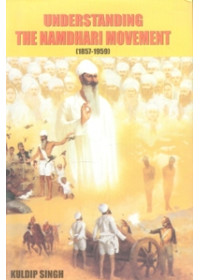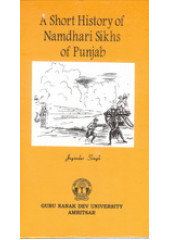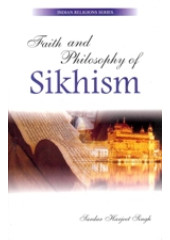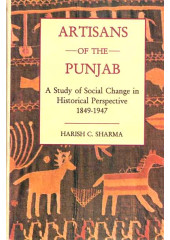Monday to Saturday - 10:00 Am to 9 PM
Now Enjoy Bulk Discounts on Books as Mentioned Below
These Discounts are in addition to the Discounts on Individual Books (Visible as Bulk Discount for Books in Cart)
Extra 10% Off If Books Purchased Exceeds Rs 3000 or 75 USD or 60 GBP or 60 Euro or 100 AUD or 100 CAD
Extra 15% Off If Books Purchased Exceeds Rs 6000 or 150 USD or 120 GBP or 120 Euro or 200 AUD or 200 CAD
Extra 20% Off If Books Purchased Exceeds Rs 15000 or 225 USD or 180 GBP or 180 Euro or 300 AUD or 300 CAD
Extra 25% Off If Books Purchased Exceeds Rs 30000 or 300 USD or 240 GBP or 240 Euro or 400 AUD or 400 CAD
Summary of 'Understanding The Namdhari Movement (1857-1959)' By Kuldip Singh
The present work studies the continuity and change in the socio-religious beliefs and practices and political attitudes of the Namdharis from 1857 to 1959. It also examines the developments in the Namdhari organisation which took place during the period under study.
The entire period under study can be divided into two phases. The first phase begins with the founding of the Namdhari mission by Baba Balak Singh (1797-1862) and ends with the 'Kuka Movement' under the leadership of Baba Ram Singh (1816-1885) and his successor Baba Hari Singh (1819- 1906). The founder exhorted his followers to discard ritualism and mediate just on the nain of God. However, it was his successor who evolved a distinct Namdhari maryada and formed the chosen followers known as Sant Khalsa to carry O? his socio-religious programme. His inain following came from the peasnats and artisan castes. Baba Ram Singh' s chrismatic personality could mobilise these followers in thousand. Conversely, when his hold over the zealous activists slackened, the movement assumed political overtones and a conforntation over the cow-issue with the government took place subsequently. Though the movement was crushed but his socio-religious mission continued under his successors. It was under the leadership of Baba Hari Singh and Baba Partap Singh ( 1890-1959) when the socio-religious beliefs and practices underwent a· change.
Moreover, it was during this period when the concept of living guru was legitimised and Baba Ram Singh was exalted to the spiritual position of Sat Guru Ram Singh as the twelfth Guru and incarnation of Guru Gobind Singh. Namdhari scholars came up with a historical explanation to institutionalise the concept of living Guru. Though nam simran remained a Namdhari significant spiritual tradition yet no ceremony was completed without a formal prayer. The text of the Namdhari 'ardas ' counted the sacrifices and achievements of Namdhari Gurus and his confidants. Moreover, with the passage of time Namdharis developed their own centres of religious worship. Baba Partap Singh founded a new Namdhari centre at Jiwan Nagar in Hissar district of Haryana. Emergence of a new N amdhari sect under Sant Harnam Singh was another development in early 20111 century.
In the post-Kuka Movement period, the Namdhari Leadership followed a policy of non-confrontration with the British Government. In response to the emergence of the . national movement, this leadership built up links with Congress leaders which eventually gave national overtones to the activities of the Namdharis. Baba Ram Singh was projected as the protagonist of the communal harmony. To show a solidarity with the nationalist forces, Baba Partap Singh took a special interest to organise political conferences for promoting communal harmony and invited the national leaders to participate in these conferences. He also took initiative to resolve the sectarian differences among the Sikhs in the wake of passage of the Communal A ward and organised a conference known as Guru Nanak Nam Leva Conference at Bhaini Sahib in 1934. N amdhari' s relations with the Akali leadership varied from hostility to cooperation depending upon the political issues and concerns.
Similarly, Baba Ram Singh' s successors brought a large number of the people into the fold of the Namdhari mission; established new centres of propaganda in and outside Punjab and expanded the net-work of organisation. They also founded their own educational institutions. Besides, Baba Partap Singh showed a special interest in founding the husbandary farms.
Scholars and historians working on the modern Punjab history have shown their main interest in the nature and scope of the 'Kuka' or N amdhari Movement under Baba Ram Singh' s leadership. Since a good number of articles and some monographs have been written exclusively on this theme, therefore, these works have been reviewed in the first section of the second chapter of this study. However, the works of M.M.Ahluwalia1 and Fauja Singh2 highlight the role of the Namdharis in the freedom struggle under the leadership of Baba Ram Singh. Besides, Stephen Fuchs3 and Khushwant Singh" give a brief account of Namdhari history, beliefs and practices in their respective works. But they do not examine those changes, which have been mentioned in the proceeding paras. There is no work which analytically deals with the above mentioned developments.
To analyse these developments, during the period under study, the work has been divided into five chapters. The first chapter analyses the evolution of the Namdhari beliefs and practices. The second Chapter examines, the nature and scope of the N amdhari Movement. It has been argued that the Namdhari Movement was essentially a socio-religious movement but it assumed political overtones subsequently. The third Chapter analyses the sectarian and national role of Namdharis under the leadership of Guru Partap Singh. The fourth chapter examines the structural changes and social background of the prominent Namdhari activists. The last chapter summerises the main conclusions.
The work is based on the primary and secondary sources. However, data available in the three volumes edited by Nahar Singh has been incorporated5. Similarly, the information given in the official documents edited by Jaswinder Singh has also been used particularly on the period from 1880 to 1903.
Besides, the hagiographical Namdhari Literature has been used for evolution of socio-religious beliefs and practices, maryad a and legitimisation of the living guruship. The interviews of the prominent Namdhari leaders and activists considerably helped me to clarify the terms, concepts and institutions of the Namdharis. The analysis of the socio-political activities of the Namdharis is based upon the contemporary newspapers and periodicals. The demographic study has been largely based on the census reports, gazeteers and the Namdhari literature.
I greatefully acknowledge the help rendered by the staff of the following institutions : the National Archives of India, New Delhi; the Nehru Memorial Musuem Library, New Delhi; the Dwarka Das Library Chandigarh; Indian Institute of Advanced Study Library, Shimla; the Sikh Reference Library, Golden Temple, Amritsar; Sikh History Research Centre, Khalsa College, Amritsar; Department of History Library and Bhai Gu rd as Library, Guru Nanak Dev University, Amritsar' Library of the Punjabi Universityespecially the collections of Dr. Ganda singh and Fauja Singh and Punjab State Archives, Patiala and Library of Sri Guru Angad Dev College, Khadoor Sahib (Tarn Taran).
I am grateful to the present Namdhari Guru Jagjit Singh Ji and his close. Associates like Shri H. S. Hanspal President Namdhari Darbar Jaswinder Singh Historian, Tara Singh Anjan, Pritam Singh Kavi of New Delhi. I am also indebted to the Namdhari families.
About The Author of 'Understanding The Namdhari Movement (1857-1959)'
Dr. Kuldip Singh (Associate Professor and Head, Deptt. of History Sri Guru Angad Dev College, Khadur Sahib Distt Tam Taran) the author of this book "Understanding the N amdhari Movement" was born, brought up and educated in the total rural environment. As far his academic qualification is concerned he took his Matriculation from G. G. S Khalsa School Sarhali (Tam Taran) M.A (History, Punjabi and English) from Guru Nanak Dev University, Amritsar and Punjabi University, Patiala. After doing his M.Phil from G.N.D. University he submitted his Ph.D. Thesis for the degree which was subsequently awarded to him in February 2000. This book will definitely serve the purpose of the readers to their full satisfaction.
Dr. Kuldeep Singh has been studying modem Sikh History for over two decades; has written several articles on socio-religious, cultural and political articulation of the Sikh under the British rule; that were later published in the journal ofRegional History and proceedings of Punjab History Conferences and Indian History Congress, has also written a monograph entitled, Namdhari Guru Ram Singh and his movement.
Understanding The Namdhari Movement (1857-1959) - Book By Kuldip Singh
- Brand: Unistar Books
- Product Code: SHE234
- Availability: In Stock
-
Rs.495.00
Related Products
Land Marks In Sikh History - A Fully Researched And Documented History : 1699 - 1947 - Book By ML Ahluwalia
About The Author Of 'Land Marks In Sikh History - A Fully Researched And Documented History : 169..
Rs.500.00
Sri Satguru Ram Singh Ji and Freedom Movement of India - Book By Yogendra Bali
Table Of Contents For 'Sri Satguru Ram Singh Ji and Freedom Movement of India' Book By..
Rs.595.00
A Short History Of Namdhari Sikhs Of Punjab - Book By Joginder Singh
Preface To 'A Short History Of Namdhari Sikhs Of Punjab' By Joginder Singh The Namdhari Sikhs Of ..
Rs.200.00
Sikh Leadership - Book By Joginder Singh
Introduction To 'Sikh Leadership' By Joginder Singh In this work the author has identified and ex..
Rs.260.00
Faith and Philosophy of Sikhism - Book By Sardar Harjeet Singh
Preface To Book of 'Faith and Philosophy of Sikhism' It may be said that the Guru Nanak ..
Rs.180.00
Namdhari Guru Ram Singh And His Movement - Book By Kuldip Singh
Preface To 'Namdhari Guru Ram Singh And His Movement' By Kuldip Singh The Namdhari Movement was o..
Rs.195.00
Reflections On Baba Dayal And Nirankari Movement - Book By Navtej Singh
Table of Contents For 'Reflections on Baba Dayal and Nirankari Movement' By Navtej Singh ..
Rs.260.00
Artisans Of The Punjab - Book By Harish C. Sharma
From The Frontcover Of 'Artisans Of The Punjab' By Harish C. Sharma Artisans and other low ..
Rs.395.00
The Sword Of The Khalsa - Book By Arjan Dass Malik
From The Frontcover Of 'The Sword Of The Khalsa' By Arjan Dass Malik The present study seek..
Rs.275.00
Tags: book by kuldip singh, understanding the namdhari movem movement, (1857-1959), sikh, history, punjab, books, english











